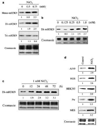Carcinogenic metals and the epigenome: understanding the effect of nickel, arsenic, and chromium
- PMID: 22473328
- PMCID: PMC3687545
- DOI: 10.1039/c2mt20033c
Carcinogenic metals and the epigenome: understanding the effect of nickel, arsenic, and chromium
Abstract
Carcinogenic metals, such as nickel, arsenic, and chromium, are widespread environmental and occupational pollutants. Chronic exposure to these metals has been connected with increased risks of numerous cancers and as well as non-carcinogenic health outcomes, including cardiovascular disease, neurologic deficits, neuro-developmental deficits in childhood, and hypertension. However, currently the specific molecular targets for metal toxicity and carcinogenicity are not fully understood. Here, we propose that the iron- and 2-oxoglutarate-dependent dioxygenase family enzymes, as well as, other histone modifying enzymes are important intracellular targets that mediate the toxicity and carcinogenicity of nickel, and maybe potential targets in chromium and arsenic induced carcinogenesis. Our data demonstrate that all three metals are capable of inducing post-translational histone modifications and affecting the enzymes that modulate them (i.e. the iron- and 2-oxoglutarate-dependent dioxygenase family, including HIF-prolyl hydroxylase PHD2, histone demethylase JHDM2A/JMJD1A, and DNA repair enzymes ABH3 and ABH2, and histone methyltransferases, G9a). Given the effects that these metals can exert on the epigenome, future studies of their involvement in histone modifying enzymes dynamics would deepen our understanding on their respective toxicities and carcinogenicities.
Figures










Similar articles
-
The Epitranscriptomic Mechanism of Metal Toxicity and Carcinogenesis.Int J Mol Sci. 2022 Oct 5;23(19):11830. doi: 10.3390/ijms231911830. Int J Mol Sci. 2022. PMID: 36233132 Free PMC article. Review.
-
Iron- and 2-oxoglutarate-dependent dioxygenases: an emerging group of molecular targets for nickel toxicity and carcinogenicity.Biometals. 2009 Feb;22(1):191-6. doi: 10.1007/s10534-008-9190-3. Epub 2008 Dec 19. Biometals. 2009. PMID: 19096759 Free PMC article.
-
Genetic and epigenetic mechanisms in metal carcinogenesis and cocarcinogenesis: nickel, arsenic, and chromium.Chem Res Toxicol. 2008 Jan;21(1):28-44. doi: 10.1021/tx700198a. Epub 2007 Oct 30. Chem Res Toxicol. 2008. PMID: 17970581 Free PMC article. Review.
-
Nickel ions inhibit histone demethylase JMJD1A and DNA repair enzyme ABH2 by replacing the ferrous iron in the catalytic centers.J Biol Chem. 2010 Mar 5;285(10):7374-83. doi: 10.1074/jbc.M109.058503. Epub 2009 Dec 30. J Biol Chem. 2010. PMID: 20042601 Free PMC article.
-
Effects of carcinogenic metals on gene expression.Toxicol Lett. 2002 Feb 28;127(1-3):63-8. doi: 10.1016/s0378-4274(01)00484-2. Toxicol Lett. 2002. PMID: 12052642
Cited by
-
2-Oxoglutarate-dependent dioxygenases are sensors of energy metabolism, oxygen availability, and iron homeostasis: potential role in the regulation of aging process.Cell Mol Life Sci. 2015 Oct;72(20):3897-914. doi: 10.1007/s00018-015-1978-z. Epub 2015 Jun 29. Cell Mol Life Sci. 2015. PMID: 26118662 Free PMC article. Review.
-
The Epitranscriptomic Mechanism of Metal Toxicity and Carcinogenesis.Int J Mol Sci. 2022 Oct 5;23(19):11830. doi: 10.3390/ijms231911830. Int J Mol Sci. 2022. PMID: 36233132 Free PMC article. Review.
-
Genetics and epigenetic factors of Wilson disease.Ann Transl Med. 2019 Apr;7(Suppl 2):S58. doi: 10.21037/atm.2019.01.67. Ann Transl Med. 2019. PMID: 31179295 Free PMC article. Review.
-
Bacteriological Quality and Heavy Metal Analysis of Packaged Water Produced in Lusaka, Zambia and Associated Quality Control Measures.Front Public Health. 2021 Jun 15;9:620700. doi: 10.3389/fpubh.2021.620700. eCollection 2021. Front Public Health. 2021. PMID: 34211949 Free PMC article.
-
Nickel induces transcriptional down-regulation of DNA repair pathways in tumorigenic and non-tumorigenic lung cells.Carcinogenesis. 2017 Jun 1;38(6):627-637. doi: 10.1093/carcin/bgx038. Carcinogenesis. 2017. PMID: 28472268 Free PMC article.
References
Publication types
MeSH terms
Substances
Grants and funding
LinkOut - more resources
Full Text Sources
Medical

